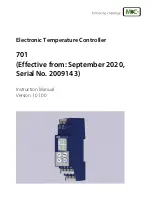
5.
Connect the negative lead of the primary power source to one of the C terminals of the
power screw terminal connector plug and tighten the terminal screw.
6.
Optionally, you can connect the positive lead of a secondary power source to the
V2 terminal and the negative lead to the other C terminal.
7.
Install the power connector plug on the front panel of the NI cDAQ-9132 and tighten the
connector screw flanges.
8.
Turn on the external power source(s).
The cDAQ controller uses V1 if the voltage across V1 and C is 9 V or greater. If the V1-to-C
voltage drops below 9 V, the NI cDAQ-9132 switches to V2. If the V2-to-C voltage is less
than 9 V, operation may be interrupted.
Note
If the NI cDAQ-9132 is using V1 and a secondary power source is connected
to V2, there is a small leakage current on V2. The leakage current depends on the
V2-to-C voltage. Refer to the
NI cDAQ-9132 Specifications
for nominal values of
this leakage current
If the power source is connected to the power connector using long wiring with high DC
resistance, the voltage at the power connector may be significantly lower than the specified
voltage of the power source.
The C terminals are internally connected to each other but are not connected to chassis ground.
You can connect the C terminals to chassis ground externally. Refer to the
section for information about the power supply input range. Refer to the
section for information about the maximum voltage from terminal to chassis
ground.
Caution
Removing power without shutting down the NI cDAQ-9132 for Windows
can corrupt the embedded Windows system drive.
Preparing the Environment
Ensure that the environment you are using the NI cDAQ-9132 in meets the following
specifications.
Temperature (IEC 60068-2-1 and IEC 60068-2-2)
Operating
-20 to 55 °C
Storage
-40 to 85 °C
Caution
Failure to follow the mounting instructions in the
NI cDAQ-9132/9133/9134/9135/9136/9137 User Manual
can cause temperature
NI cDAQ-9132 Safety, Environmental, and Regulatory Information
|
© National Instruments
|
5

























